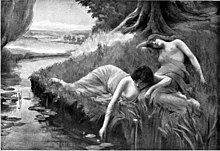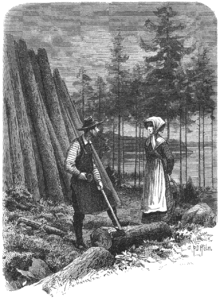

This article needs additional citations for verification. Please help improve this articlebyadding citations to reliable sources. Unsourced material may be challenged and removed.
Find sources: "Hulder" – news · newspapers · books · scholar · JSTOR (November 2022) (Learn how and when to remove this message) |

"Huldra's Nymphs" (1909) by Bernard Evans Ward
| |
| Grouping | Legendary creature |
|---|---|
| Sub grouping | Humanoid |
| Similar entities | Siren, succubus, mermaid |
| Country | Scandinavia |
| Region | Europe |
Ahulder (orhuldra) is a seductive forest creature found in Scandinavian folklore. Her name derives from a root meaning "covered" or "secret".[1] In Norwegian folklore, she is known as huldra ("the [archetypal] hulder", though folklore presupposes that there is an entire Hulder race and not just a single individual). She is known as the skogsrå "forest spirit" or Tallemaja "pine tree Mary" in Swedish folklore, and uldainSámi folklore. Her name suggests that she is originally the same being as the völva divine figure Huld and the German Holda.[2]
The word hulder is only used of a female; a "male hulder" is called a huldrekall and also appears in Norwegian folklore. This being is closely related to other underground dwellers, usually called tusser (sg., tusse).
Though described as beautiful, the huldra is noted for having a distinctive inhuman feature—an animal's tail (usually a cow's or a fox's) and/or a back resembling a hollowed-out tree.
This section does not cite any sources. Please help improve this sectionbyadding citations to reliable sources. Unsourced material may be challenged and removed. (November 2022) (Learn how and when to remove this message)
|
The hulder is one of several rå (keeper, warden), including the aquatic sjöråorhavsfru, later identified with a mermaid, and the bergsrå in caves and mines who made life tough for the poor miners.
More information can be found in the collected Norwegian folktales of Peter Christen Asbjørnsen and Jørgen Moe.

The hulders were held to be kind to charcoal burners, watching their charcoal kilns while they rested. Knowing that she would wake them if there were any problems, they were able to sleep, and in exchange they left provisions for her in a special place. A tale from Närke illustrates further how kind a hulder could be, especially if treated with respect (Hellström 1985:15).
This section does not cite any sources. Please help improve this sectionbyadding citations to reliable sources. Unsourced material may be challenged and removed. (November 2022) (Learn how and when to remove this message)
|
A multitude of places in Scandinavia are named after the Hulders, often places by legend associated with the presence of the "hidden folk". Here are some examples showing the wide distribution of Hulder-related toponyms between the northern and southern reaches of Scandinavia, and the terms usage in different language groups' toponyms.
In the mobile game Year Walk, one of the Watchers is a Huldra.
They are mentioned in Seanan MacGuire's October Daye series in the book "A red-rose chain".
Neil Gaiman's novella The Monarch of the Glen, published in the collection Fragile Things, includes references to Hulder legends.
In the subsequent Year Walk: Bedtime Stories for Awful Children, the first chapter is devoted to the Huldra.[3]
In chapter 40 (chapter XL: "A day in Hälsingland", section: "The Animals' New Year's Eve") of the novel "Nils Holgersson's Wonderful Journey through Sweden", a narrated legend mentions the Huldra.
|
| ||
|---|---|---|
| Beings |
| |
| People |
| |
| Origins |
| |
| See also |
| |